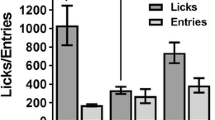Abstract
3 experiments examined the effects of deprivation level, sodium saccharin concentration, and sucrose concentration on uninterrupted bursts of licking in adult male albino rats. All dipsogenic treatments produced statistically significant changes in lick rate. The findings are viewed as challenging the hypothesized invariance of mammalian lick rates and as offering an improved measure for the study of drinking behavior in mammals.
Similar content being viewed by others
References
BLASS, C. M. 1973. Cellular-dehydration thirst: Physiological, neurological and behavioral correlates. In A. N. Epstein, H. R. Kissiloff, & E. Stellar (Eds.), The neurophysiology of thirst: New findings and advances in concepts. New York: Winston-Wiley. P. 68.
CONE, D. M. 1974. Do mammals lick at a constant rate? A critical review of the literature. The Psychological Record, 24, 353–364.
CONE, A. L., & CONE, D. M. 1973. Variability in the burst lick rates of albino rats as a function of sex, time of day, and exposure to the test situation. Bulletin of the Psychonomic Society, 2, 283–284.
CONE, D. M., CONE, A. L., GOLDEN, A. J., & SANDERS, S. L. 1973. Differential lick rates in opossum: A challenge to the invariance hypothesis. The Psychological Record, 23, 343–347.
CORBIT, J. D., & LUSCHEI, E. S. 1969. Invariance of the rat’s rate of drinking. Journal of Comparative and Physiological Psychology, 69, 119–125.
CRESPI, L. P. 1944. Amount of reinforcement and level of performance. Psychological Review, 51, 341–357.
DAVIS, J. D., & KEEHN, J. D. 1959. Magnitude of reinforcement and consummatory behavior. Science, 130, 269–271.
EDWARDS, A. L. 1972. Experimental design in psychological research (4th ed.) New York: Holt, Rinehart & Winston.
SCHAEFFER, R. W., & DAVID, M. 1973. Lick rates in gerbils. Bulletin of the Psychonomic Society, 2, 257–260.
SCHAEFFER, R. W., & HUFF, R. 1965. Lick rates in cats. Psychonomic Science, 3, 377–378.
SCHAEFFER, R. W., & PREMACK, D. 1961. Licking rates in infant albino rats. Science, 134, 1980–1981.
STELLAR, E., & HILL, J. H. 1952. The rat’s rate of drinking as a function of water deprivation. Journal of Comparative and Physiological Psychology, 45, 96–102.
ZUCKER, M. H. 1969. Electronic circuits for the behavioral and biomedical sciences. San Francisco: Freeman.
Author information
Authors and Affiliations
Additional information
Drs. Al and Donna Cone, and Robert Wells are now at Lynchburg Training School and Hospital, Lynchburg, VA.
Rights and permissions
About this article
Cite this article
Cone, A.L., Wells, R., Goodson, L. et al. Changing Lick Rate of Rats by Manipulating Deprivation and Type of Solution. Psychol Rec 25, 491–498 (1975). https://doi.org/10.1007/BF03394341
Published:
Issue Date:
DOI: https://doi.org/10.1007/BF03394341




